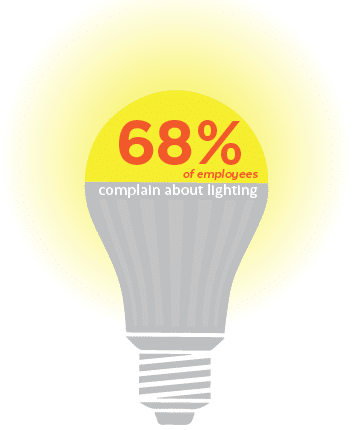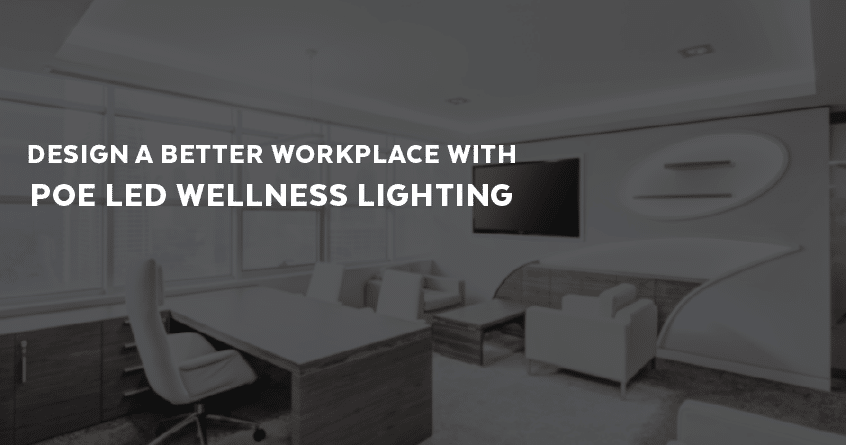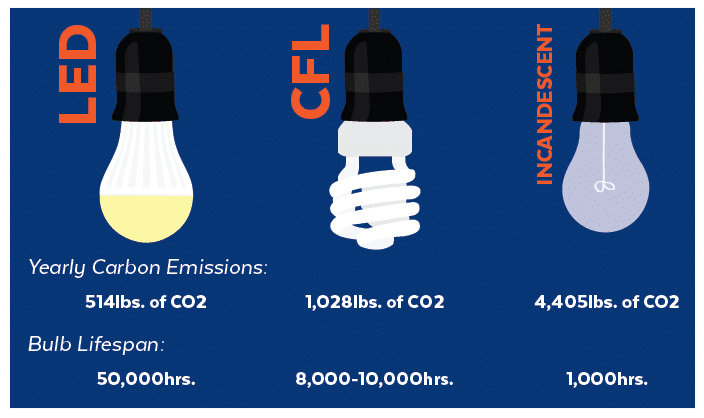Remember how lighting for an office used to be? Rows of fluorescent lights looming from the ceiling—bulbs flickering and buzzing—only two settings available: on and off. This scene is a far cry from today’s PoE LED wellness lighting solutions. If this describes your place of work even now, it is time for a change.
The modern workspace in 2021 embraces concepts such as instant space reconfiguration that accommodates one person working alone or a team of collaborators who need to group together, ergonomically sound seating that adjusts to help fight fatigue and colors that evoke feelings of safety, creativity, and concentration. Unfortunately, proper lighting is often left off this list.
The role of lighting is much more extensive than just illuminating the dark. According to John Goscha, founder and CEO of Lucidity Lighting, “We actually have pathways in our eyes and certain cells that are there that don’t detect light for vision, but actually to regulate our body’s hormones. The light that your eyes ingest does affect your hormones. How you feel affects how energized you feel during the day, and that affects how well you sleep at night.”
LED Wellness Lighting
Light-emitting diode (LED) lighting is well known for things like good performance, reduction of energy use, and long-term savings. However, it has proven to be far more beneficial than that. Installing a quality LED lighting system in your office will help create a healthy environment that increases employee wellness and productivity.
Let’s take a look at a few of these benefits.
Lighting Can Increase Employee Productivity

Light has a profound effect on the human body. It has a significant impact on an employee’s perception of their work environment, their mood, and their performance. A study conducted by the American Society of Interior Design found that 68 percent of employees complain about the lighting in their workspace. The two biggest complaints: lighting is either too dim or too harsh.
LED lights mimic natural light and have a high Color Rendering Index (CRI). Per Westinghouse:
Color Rendering Index (CRI) is a way to measure a light source’s distinctive attribution. It is an assessment of how the light source shows object colors “naturally” when compared to a familiar basis of reference, with incandescent light or daylight.
Lighting Regulates Circadian Rhythm
According to the Sleep Foundation:
Circadian rhythms are 24-hour cycles that are part of the body’s internal clock, running in the background to carry out essential functions and processes. One of the most important and well-known circadian rhythms is the sleep-wake cycle.
Different systems of the body follow circadian rhythms that are synchronized with a master clock in the brain. This master clock is directly influenced by environmental cues, especially light, which is why circadian rhythms are tied to the cycle of day and night.
Traditional lighting solutions were never designed to deal with circadian rhythm. And not all LED lighting systems address it either. However, spectrally optimized LEDs target a photopigment (called melanopsin) in the human eye that sends signals to the brain to help regulate its internal clock, as well as other biological functions. Spectrally optimized LEDs are designed with the human circadian system in mind and “can create a white light providing high daytime circadian stimulus without changing the color of the light throughout the day” which is an accurate reflection of the outside daytime sky.
LED Lighting Generates Less Heat
Unlike traditional incandescent bulbs and compact fluorescent lights (CFLs), LED bulbs operate at a low temperature that has a minimum impact on the room temperature. As a result, air conditioners do not have to work as hard. Another benefit of LED’s low heat and lack of UV rays is that bugs and insects are not attracted to them as they are with traditional light, which are bug magnets.
LED Lighting is Eco-Friendly
LED lighting has a small carbon footprint. Per global LED manufacturer, Senior LED:
The carbon emission of an LED light is 514 lbs. of CO2 per year which is much lower in comparison to carbon emissions of CFL and incandescent bulbs. 1028 and 4405 lbs. of CO2 is recorded every year from CFL and incandescent bulbs respectively. The higher the carbon emission, the greater harm your lighting product is doing to the environment.
In addition, high quality LED bulbs have a lifespan of 50,000 hours or more, while an incandescent bulb lasts for approximately 1,000 hours and CFLs average 8,000 to 10,000 hours. With LED lighting products, far fewer replacement bulbs are needed and system maintenance is low.
LED Lighting is Safe
LED lighting systems help promote a safe, pleasing environment in which your employees can do their best work. Here are five of the greatest LED safety features:
- No mercury
- Negligible UV rays
- Less heat
- No bugs
- No flickering
- No noise
LED Wellness Lighting is Smart
Quality LED lighting systems have smart features such as scheduling, dimming, and wireless control. The system can be remotely controlled, thus influencing the workplace environment as needed with a single click.
Wellness + LED Lighting Is Better for Everyone
Today’s modern work environments need to be “human-centric.” The safety and welfare of employees should be paramount to any organization. Providing a healthy, safe, and welcoming work environment is not only the right thing to do, but will benefit employers in many ways, such as lower absenteeism, increased efficiency and productivity from workers, and a safe, pleasant environment that decreases stress. In short: healthy, happy workers are the most valuable asset a company can have.
Versa Technology is a leading global company that delivers the highest quality networking technologies to IT professionals. Our POE switches pair well with LED lighting solutions.
———
For further reading, click here.


